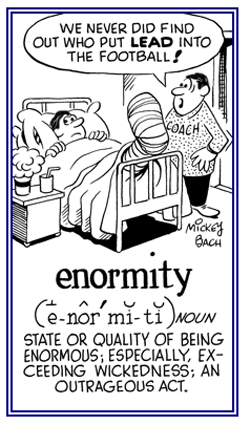norm-, normo-
(Latin: rule, pattern; normalis, "right angled, made according to a carpenter's or mason's square"; then, "conforming to common standards, usual")
2. Unusual or unexpected, especially in a way that causes alarm or anxiety: The abnormal extremes in weather conditions are causing officials to declare mandatory evacuations which is resulting in a great deal of stress for residents in certain areas of the world.
3. Pertaining to something much greater than expected or usual: Abnormal profits might be blamed for the financial crisis that exists in the present time.
4. Regarding a departure from what is typical or what is usually expected, for example in intelligence and physical development: The parents were very distressed when they found out that their daughter was considered to be intellectually abnormal in school.
The abnormal circumstances surrounding Gertrude's decision to travel caused a great deal of concern for her parents.
The neighbor's cat has an abnormal fear of birds.
5. Etymology: This word was once spelled anormal and it came from the Greek anomalos, meaning irregular. Later the b was added by analogy with the Latin word for irregular, abnormis from Latin ab-, "from" + norma, "norm"; and so, "away from the norm".Abnormal can mean either "below normal" or "above normal"; so, either better or worse than normal: Einstein had an abnormal IQ while an ignorant person also has an abnormal IQ. On the other hand, "subnormal" always means below or worse than normal.
A clubfoot is an abnormality that can be surgically corrected or improved.
2. A feature or characteristic that is not usual or ordinary, especially something that is worrying or which shows that there may be something wrong or harmful: The dictionary lists several abnormalities which can be considered mental health issues.3. A difference in intelligence that falls outside the conventional range of intelligence: Greg's school is providing special classes for students with abnormalities who need special educational procedures.
2. An irregularity or monstrosity: The veterinarian recognized the abnormity of the birth of the calf when he saw that it had two heads.
In the past, traveling circuses often featured people and animals with abnormities which attracted the audiences into the special exhibitions.
2. An excessive wickedness or outrageousness, a monstrous offense or evil; an outrage: Enormity is frequently misused to refer simply to the property of being great in size or extent, but there are many who prefer that "enormousness" or a synonym; such as, "immensity" be used for this general sense and that enormity be limited to situations that demand a "strong negative moral judgment".
This distinction between enormity and "enormousness" has not always existed historically, but nowadays many realize the differences.


Go to this Word A Day Revisited Index
so you can see more of Mickey Bach's cartoons.
2. Etymology: from Latin where the norm- root appeared after the prefix e- (a variant of ex-), meaning "out of", resulting in enormis, literally "abnormal, irregular".
The term acquired the specific sense of departing from the "norm" by being much larger in size than usual; that is, "huge" which is now the most common meaning of the English descendant of enormous.
2. In education, a designated standard of average performance of students of a given age, background, etc.; or a standard based on the past average performance of a given individual: Sally's daughter scored well above the norm in all of her courses this year.
3. The most frequent behavior that the members of a group will show in a specific situation: Warren is strict about maintaining the legal norm when he is driving by not exceeding the speed limit and paying attention to the conditions when he is driving on the city streets and highways.
2. A tragic two act opera by Vincenzo Bellini of the bell canto style: Many famous female opera singers have sung the title role of Norma.
2. Physically, mentally, and emotionally healthy; the standard of performance in a given function or test, usually taken from the average or median achievement for the group concerned: The normal development of children includes phases of rapid physical growth as well as topsy turvy emotional adjustments as each individual seeks to understand his or her feelings.
3. Maintained or occurring in a natural status: High winds and sandstorms are normal occurrences on vast desert expanses.
4. In mathematics, descriptive of a line, or plane, that is perpendicular to another line or plane: The architect used a T-square to draw a normal line perpendicular to the cobblestones drawn on the plans to indicate where the gate in the garden should be located.
5. Etymology: from Late Latin normalis, "according to rule"; from Latin, "according to a square, forming a right angle"; from norma, "carpenter's square, pattern, rule"; believed to be from Greek gnomona, accusative of gnomon, "interpreter, discerner, pointer on a sundial, carpenter's square" + -alis, "-al"; a suffix that forms adjectives.
The etymological background of the term, normal
The basic sense of the noun "norm" is "an authoritative standard or model". This is derived from the Latin "norma" which means "rule or pattern" as well as "a carpenter's square", because a square provides a standard or rule which ensures that a carpenter can regularly reproduce corners and edges which are straight and that form right angles.
- The Latin adjective "normalis", formed from "norma", originally meant "forming a right angle" or "according to a square", and it is from this Latin sense that we get the earliest attested (established as genuine) sense of normal in English, which was "perpendicular".
- Latin "normalis", was also used in more extended senses, and by the Late Latin period, its usual meaning was "according to rule" and so it was that most of the meanings of the English word, normal, have been derived from this Late Latin usage.
- The Latin "norma", "carpenter's square", is thought by some linguists to be derived from Greek "gnomon", which also means "carpenter's square".
- Additional senses are "the pointer on a sundial", "interpreter", and "discerner".
- All of these meanings reflect in varying degrees the origin of the word in the verb "gignoskein", "to know".
- "Gnomon" was borrowed into English directly from Greek and is still used to mean "the style of a sundial" as well as other senses derived from or related to this.
When compared to students in other universities, the normal distribution of grades in English classes for Susan and the other students at the local university was favorable.
The evolution of electronic microscopes enabled scientists of normal histology to better understand and compare healthy tissues and diseased tissues.
2. Etymology: a "normal school" came from French ecole normale and is derived from the fact that the first school was intended to serve as a standard, or model, to be used by other schools for training teachers.

